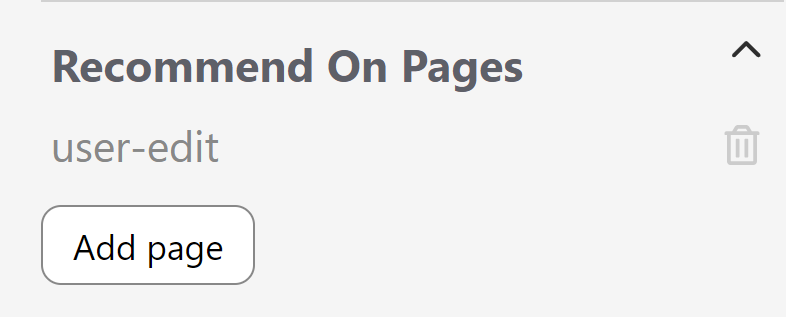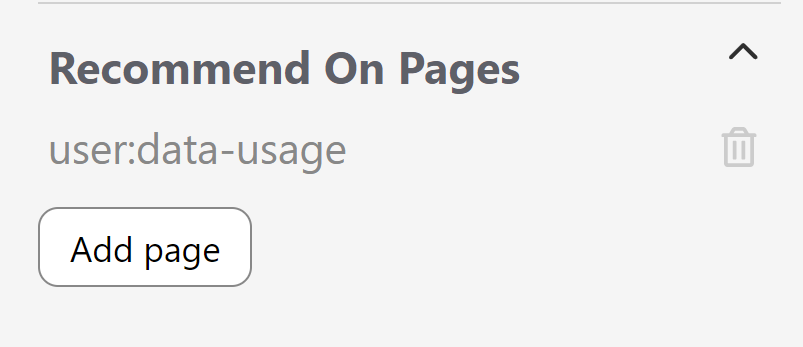These instructions relate to a deprecated feature
As of August 2022, we have deprecated the Legacy and Modern widgets. Refer to Deprecation of Modern & Legacy widget for more information.
The Problem
If you've set up "Recommend on Pages" for contextual help, by default, when a reader navigates to a new page, the widget grabs that URL and uses it to suggest contextual help content. This method works fine for applications that use full page reloads during navigation.
However, for single page applications this is not the case. In single page applications, the reader might have navigated to an entirely new area of your application, and while the URL may reflect that, the page never fully reloads and thus neither does the widget. This can result in confusion when the reader opens the widget, since the suggested articles may relate to the first page they saw instead of the page they're currently looking at.
The Solution
To solve this problem, you can call the widget __ko.16.updatePageLoc method to proactively tell the widget that the current URL has changed:
//method to update the current URL used for contextual help
__ko16.updatePageLoc('currentUrl');
Example Usage
In the below example, we will attach an event to the HTML element that opens the widget so that when the reader opens the widget we can update the current location with our own custom value:
//In this example, the widget settings specify "Attach to Element" which uses the ID of an HTML element to open the widget
//In our example app we've attached the widget to an element with an ID of "ko-widget"
var widgetTriggerElement = $('#ko-widget');
//standard widget embed code
var _ko16_p = _ko16_p || [];
_ko16_p.push(['_setProject', '123123123123123-123123123123']);
(function() {
setTimeout(function(){
var ko = document.createElement('script');
ko.type = 'text/javascript';
ko.async = true;
ko.src = "//example.mysite.com/javascript/ko-index?__pc=123123123123123-123123123123";
document.head.appendChild(ko);
/*** NEW CODE ***/
ko.addEventListener('load', function(){
pushCurLocation(0);
});
},250);
})();
//new function to listen for the trigger that opens the widget to pass the new location
var pushCurLocation = function(attempts) {
setTimeout(function(){
if(typeof __ko16 !== 'undefined') {
widgetTriggerElement.on('click', function(){
/*** UPDATE THIS LINE TO USE WHATEVER METHOD YOU WISH TO SPECIFY THE CURRENT PAGE LOCATION ***/
var currentUrl = 'window.location.pathname';
__ko16.updatePageLoc(currentUrl);
});
} else if(attempts <= 4) {
attempts++;
pushCurLocation(attempts);
}
}, 250);
}
Other Reasons for Using This Method
Even if your application is not a single page application, your app's URLs may be constructed in a way that make it very difficult to utilize the "Recommend on Pages" feature.
Another benefit of this function is that it can accept any string value as the "currentUrl" parameter which allows you to use a single word or any other format you wish in place of the actual URL. Take a look at the below examples:
Complex URLs to Simple One Word Location
Let's say that you have an application URL that looks like this:
https://myapp.com/app/users/edit-user/abcd123354/id/123151ajsdfa?p=12sdfsd12&q=12154aba
By default, the following is what gets sent as the current location to the widget:
/app/users/edit-user/abcd123354/id/123151ajsdfa
If we leave this as is, we would need to use regex to make sure that the ID portions of the URL get genericized so that we wouldn't need to add a "Recommend On Pages" URL for every single ID possible. So what we'd need to add to articles in the Recommend On Pages section would look some thing like this:
/app/users/edit-user/{custom}/id/{custom}While that will work, it is still a fairly complex way to essentially say that we want certain articles to appear when people are looking at the "edit-user" screen. By using the "updatePageLoc" method, we can dramatically simplify this like so:
//define current page and send to widget
var currentUrl = 'user-edit';
__ko16.updatePageLoc(currentUrl);
By using the above method, we can now tell our KnowledgeOwl authors that if they want a certain article to appear as recommended on the "user-edit" pages in the widget, they can add the string "user-edit" to the "Recommend On Pages" text box like so:

Dealing with More Complex Page Paths
You might find that you need to be more specific with which page a reader is looking at. Let's look at the following URLs for example:
https://myapp.com/app/users/user/id/123123abasd/reports/data-usage https://myapp.com/app/account/id/asdfksa1233123/reports/data-usage
Both of these URLs are referencing a page that shows a report of "data-usage". However, one of the URLs is referencing the data usage for a single user while the other is referencing the overall data usage for the entire account. If we were to only pass over "data-usage" as the current page, this could cause confusion with the content that gets recommended within the widget.
Because the "updatePageLoc" function is flexible and accepts any string value, we can handle this in whatever way that will make the most sense to our KO authors. For example, we could send the current page location like so:
//Page: https://myapp.com/app/users/user/id/123123abasd/reports/data-usage
var currentUrl = 'user:data-usage';
__ko16.updatePageLoc(currentUrl);
//Page: https://myapp.com/app/account/id/asdfksa1233123/reports/data-usage
var currentUrl = 'account:data-usage';
__ko16.updatePageLoc(currentUrl);
We can then tell our KnowledgeOwl authors to make sure they specify the section of the app followed by a ":" followed by the page of the app when using the "Recommend On Pages" text area:

This flexibility allows you to come up with a naming convention that will make sense to both the developers that install the widget and the people that are actually writing the documentation.
Example Usage
Extremely simple example HTML page for https://myapp.com/app/users/user/id/123123abasd/reports/data-usage where the "currentUrl" value is passed to the view via the controller or it is populated in some other way dynamically:
<!DOCTYPE html>
<html>
<head>
<title>Data Usage Report for John Smith</title>
</head>
<body>
<!-- {{currentUrl}} is passed to view via the controller or otherwise populated dynamically -->
<input type="hidden" id="currentUrl" value="{{currentUrl}}">
</body>
</html>
The below code uses the value of the HTML element "#currentUrl" that we populated above:
//In this example, the widget settings specify "Attach to Element" which uses the ID of an HTML element to open the widget
//In our example app we've attached the widget to an element with an ID of "ko-widget"
var widgetTriggerElement = $('#ko-widget');
//standard widget embed code
var _ko16_p = _ko16_p || [];
_ko16_p.push(['_setProject', '123123123123123-123123123123']);
(function() {
setTimeout(function(){
var ko = document.createElement('script');
ko.type = 'text/javascript';
ko.async = true;
ko.src = "//example.mysite.com/javascript/ko-index?__pc=123123123123123-123123123123";
document.head.appendChild(ko);
/*** NEW CODE ***/
ko.addEventListener('load', function(){
pushCurLocation(0);
});
},250);
})();
//new function to listen for the trigger that opens the widget to pass the new location
var pushCurLocation = function(attempts) {
setTimeout(function(){
if(typeof __ko16 !== 'undefined') {
widgetTriggerElement.on('click', function(){
/*** REFERENCE TO THE HIDDEN INPUT HTML ELEMENT FROM ABOVE ***/
var currentUrl = $('#currentUrl').val();
__ko16.updatePageLoc(currentUrl);
});
} else if(attempts <= 4) {
attempts++;
pushCurLocation(attempts);
}
}, 250);
}

